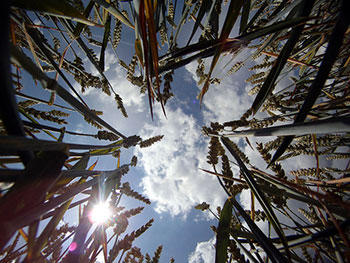Stewart Collis, CTO and co-founder of AWhere, recently tweeted a link to a video by the University of Minnesota’s Institute on the Environment, Big Question: Feast or Famine? The video highlights the increasing complexity of feeding our rapidly growing population, and Collis noted its relation to his work at AWhere. I recently caught up with Collis to talk about our current global agriculture situation, the impact of big data on agriculture, and the work his company is doing to help address global agriculture problems.
The challenge, explained Collis, is two-fold: our growing population — expected to increase by another 2.4 billion people by 2050, and the increasing weather variability affecting our growing seasons and farmers’ abilities to produce and scale to accommodate that population. “In the face of weather variability, climate change, and increasing temperatures … farmers no longer know when it’s going to rain,” he said, and then noted: “There’s only 34 growing seasons between now and [2050], so this is a problem we need to solve now.”
AWhere has developed a global weather database platform, Weather Terrain, that pulls in historical weather data to help farmers better forecast and plan. “We have up to 20 years of daily weather history for any location on the planet in agricultural areas,” Collis said. “We can build models on that data, we can look at risk, and we can run forecasts and run pest and disease model forecasts on that data.”
The models, Collis noted, can be scaled down to the hyperlocal level — to a single field, in fact. “This is critical for agriculture,” he said, “because of the fine thresholds we’re dealing with that affect plant growth and plant physiology.”
Hyperlocality is important for another reason that Collis highlighted during our chat — much of the population growth is expected to occur in developing countries, where agriculture often depends on smallholder farmers working on one to two acres. Working with local farmers in developing countries presents a number of interesting logistical challenges, he said, not the least of which is the widespread use of feature phones (as opposed to smartphones). Regional agriculture centers typically access the Weather Terrain interface on a desktop platform, but often will communicate with local farmers via text messages, so adapting the delivery of information becomes an issue.
Collis told the story of one group in Ghana that worked with AWhere to develop an app on top of Weather Terrain’s open API:
“They were delivering information to feature phones, and that’s a challenge — and some of the farmers are not literate. You can use voicemail, but that’s expensive. Text messages are cheaper. What we did was collapse our forecast down to an aggregate, to a smaller number of periods per day, and we collapsed the forecast — partly sunny, partly cloudy, windy, that sort of thing — down to a smaller bunch of categories so they could convert that to ASCII character images on the feature phone. That gave the farmer something that was interpretable enough to take an action.”
The expense considerations Collis mentioned are key, especially in helping farmers in developing countries. Among the logistical considerations, he noted the finance challenges in ensuring local farmers have enough credit on their phones to receive text messages. There are also geographic challenges and local policy considerations. “What we mostly do is work with partners,” Collis said. “We find other private organizations working in the region, or we work with some of the international development agencies.”
Making precision farming accessible and affordable for farmers in general — in the U.S. as well as in developing countries — is an interesting challenge, but becoming more and more possible as the costs of connected sensor technology drops. “We’ve had precision farming for a long time,” Collis noted, “but it was really adopted by larger corporate organizations and large farms — not really affordable for smaller farmers.” The challenge, he said, is how to “leverage cheaper and cheaper sensors, and get that information integrated in a way that make sense, that can provide value and, really, decision support systems.”
Also in this podcast…
Following my chat with Collis, we’ve got a special feature: 3 Questions with Scott Donaldson, senior director at FINRA. We chat about market regulation surveillance and how FINRA processes and analyzes 30 billion events per day.
You can listen to this podcast episode in the player embedded above or download it through TuneIn, SoundCloud, or iTunes.
Image on article and category pages by Martin Fisch on Flickr, used under a Creative Commons license.

